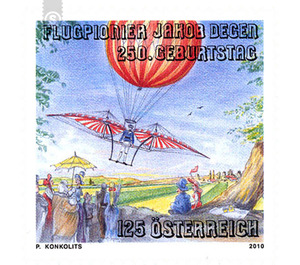250th birthday - Austria / II. Republic of Austria 2010 - 125 Euro Cent
Theme: Traffic, Transportation & Mobility
| Country | Austria / II. Republic of Austria |
| Issue Date | 2010 |
| Face Value | 125.00 |
| Edition Issued | 160,000 |
| Printing Type | offset |
| Stamp Type | Commemorative |
| Item Type | Stamp |
| Chronological Issue Number | 2235 |
| Chronological Chapter | OOS-OE2 |
| SID | 668384 |
| In 59 Wishlists | |
Jakob Degen, born on February 27, 1760 in Liedertswil in Switzerland, went down in history as a highly creative inventor and aviation pioneer. The new special stamp is a tribute to this great spirit of the 18th and 19th centuries. About the person: Originally, Degen, who had been living in Vienna since his childhood, was a band weaver, but from 1778 he learned the craft of watchmaking, where he passed the master's examination in 1792. In 1807 he designed his first aircraft, which was equipped with movable wings that were powered by muscle power. A year later, he provided this flapping aircraft with a hydrogen balloon, which generated the necessary buoyancy for flying. With this so-called "Ornithopter" Jakob Degen managed the first controlled free flight in November 1808 - the motif on the special stamp is a charming reminder of this early adventure. 1810 to 1813 he led the aircraft in Vienna, more precisely on the route from Laxenburg to Vösendorf, and in Paris several times before the public; However, a flight test on the Campus Martius in Paris failed and caused great disappointment among the excited watching spectators. His knowledge as a watchmaker finally benefited him, as he constructed in 1816 a propeller with clockwork drive. This world's first unmanned helicopter model reached a height of at least 160 meters at a demonstration in the Vienna Prater. Jakob Degen, however, also dealt with topics of a very different kind. For example, he invented a machine for cutting clock wheels, as well as a languette for band weaving (weaving technique) and an entirely new anemometer for the time. In the years 1816-1820 he finally created a forgery-proof method for double-sided and multiple printing of banknotes, a so-called "guilloche engraving" or "Guillochiergerät", which made the printing of complicated wavy line patterns (guilloches) possible. This invention is still today the basis of banknote and security printing in many countries. From 1825 to 1841 he was head of the mechanical workshops of the Austrian National Bank, on August 28, 1848 Jakob Degen died in Vienna. On the other hand, you can still walk on Degen's inventive footsteps: For example, the Technisches Museum exhibits some of his original models, and the clock museum features an interesting stick clock with a pendulum showing the figure of the "Flying Watchmaker Jakob Degen".


